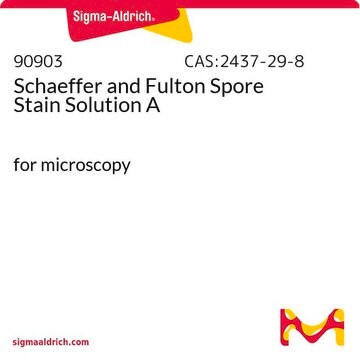221082
Mercury(II) oxide yellow
ACS reagent, ≥99.0%
Synonyme(s) :
Mercuric oxide yellow
About This Item
Produits recommandés
Qualité
ACS reagent
Niveau de qualité
Pureté
≥99.0%
Forme
powder
Pertinence de la réaction
reagent type: catalyst
core: mercury
Impuretés
≤0.005% N compounds
≤0.03% insol. dil. HCl
Résidus de réduction
≤0.05%
Pf
500 °C (dec.) (lit.)
Traces d'anions
chloride (Cl-): ≤0.025%
sulfate (SO42-): ≤0.01%
Traces de cations
Fe: ≤0.003%
Chaîne SMILES
O=[Hg]
InChI
1S/Hg.O
Clé InChI
UKWHYYKOEPRTIC-UHFFFAOYSA-N
Vous recherchez des produits similaires ? Visite Guide de comparaison des produits
Description générale
Application
Mention d'avertissement
Danger
Mentions de danger
Conseils de prudence
Classification des risques
Acute Tox. 1 Dermal - Acute Tox. 2 Inhalation - Acute Tox. 2 Oral - Aquatic Acute 1 - Aquatic Chronic 1 - STOT RE 2
Organes cibles
Kidney
Code de la classe de stockage
6.1B - Non-combustible acute toxic Cat. 1 and 2 / very toxic hazardous materials
Classe de danger pour l'eau (WGK)
WGK 3
Point d'éclair (°F)
Not applicable
Point d'éclair (°C)
Not applicable
Certificats d'analyse (COA)
Recherchez un Certificats d'analyse (COA) en saisissant le numéro de lot du produit. Les numéros de lot figurent sur l'étiquette du produit après les mots "Lot" ou "Batch".
Déjà en possession de ce produit ?
Retrouvez la documentation relative aux produits que vous avez récemment achetés dans la Bibliothèque de documents.
Les clients ont également consulté
Notre équipe de scientifiques dispose d'une expérience dans tous les secteurs de la recherche, notamment en sciences de la vie, science des matériaux, synthèse chimique, chromatographie, analyse et dans de nombreux autres domaines..
Contacter notre Service technique















